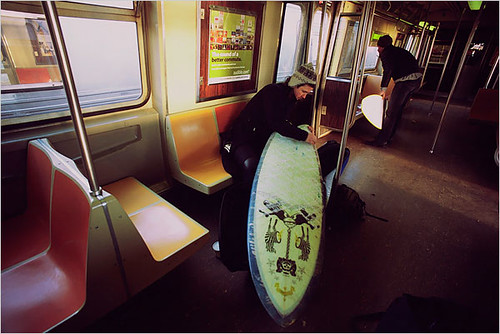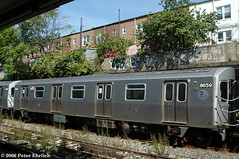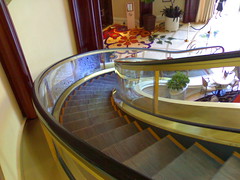Long term planning necessary for dealing with transit crush loads
Transit "crush loads," the number of people crammed into a bus or subway cars, are much lower in the U.S. than they are in places like Japan or Latin America.
Bus crush loads in Latin America are double those in the U.S., meaning that they can fit 150 people on a 60 ft. articulated bus, whereas we get about 80 people into the same space.

Look at how many people have gotten off these buses in Bogota. New York Times photo.
And of course, there are the stories from Japan where platform attendants push people onto the train cars to cram more people in.

Chikatetsu train in Japan. Photo from The Atlantic.
We needed those kind of platform attendants on WMATA's red line a couple mornings ago.
I don't usually ride the subway in the morning, normally I bicycle directly to Union Station, but I was running a bit behind and had been working hard for the past few days writing a section of plan so I was tired, and instead I went to Takoma sparing myself the bicycle ride. But I ended up missing my MARC passenger train because of the added time required at each station to get people on and off the subway riding between Takoma and Union Station.
The platforms were packed because of a reduction in train size and the number of trains provided per hour of "rush hour" service.
The trains were packed "for DC," but you could see that in terms of Latin American or Japan style crush loads, you could fit in way more people. At least 30 more people per car. I did my part by pushing through and filling gaps successively, enabling more people to get into the train at subsequent stops. It didn't make me a popular rider.
I thought it was an interesting exercise though as it made me think of the day in a decade or so, when ridership peaks at about 1.2 million people per day.
How will the system deal? If it is organized the same way it is today, it won't be able to--and remember, the maximum length of a train is 8 cars.
There are at least four areas where WMATA could focus, to significantly improve throughput and capacity on trains and stations. Platforms are fixed and can't be expanded, so throughput (getting people in and out efficiently) really matters.
1. ways into stations. Stairs can be added in certain stations (like Union Station). Or fancy curved escalators, to cram in another escalator and fix the flawed travelways to get people in and out of stations more quickly. Union Station is a particular problem when commuter trains discharge huge passenger loads and there is a continuous line from the train platform to the subway entrance. (This was attempted a few years ago and the Board wimped out on the proposals.)
(I don't know how to fix the platform problem at Gallery Place. It's a design flaw as the red line platforms are more a 90 degree angle shifted (an "L") from the yellow/green line platforms below, rather than being more balanced, in a cross formation like this:
☩, so that more of the red line platform would be located more closely to the entrance ways into the station and from the platforms below.)
3. The internal configuration of cars has to change. There need to be fewer seats, even though we all love to sit, so that more people can fit onto the cars. This has always been a problem for WMATA because the subway system is a hybrid, providing the equivalent of long distance commuter trips for people from western Northern Virginia and upper Montgomery County, and relatively short distance trips for people in inner Montgomery County, DC, and Arlington County.
I think the only way to deal with this is to have a mix of cars on trains. Have some cars be more NYC like, with bench seating, and have some cars like the current cars, to better accommodate long distance riders.

On the #6 Subway in NYC.

You can see from this photo that the interior configuration of typical NYC subway cars allows for maximum passenger loads. NYT photo.
4. More doors on trains. I advocate for 4 door trains instead of 3 door trains, in order to speed entry and exiting.

NYC R160 subway car, with four doors, photo from the NYC Subway website.
Waiting around to 2018 to start dealing with this will be a mistake.

Crush on a weekend 4 car WMATA subway train.
Labels: transit, transportation infrastructure, transportation planning




0 Comments:
Post a Comment
<< Home